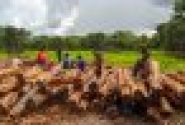
Forest-based social movements possess a unique power in forming alliances with local government, conservationists, the timber industry and agricultural concessionaires. Nagarjun Kandukuru
BOGOR, Indonesia (6 March, 2013)_Organisations working collectively in Guatemala and Nepal are succeeding in giving a voice to people living in and around forests, experts say. They are also showing a willingness to challenge state laws and force authorities to be more accountable when managing the country’s dwindling natural resources.
Though the dynamics of community-level institutions have been well documented, second-level organisations, as they are called, have received far less attention.
But these forest-based social movements, which form alliances within the local government, conservationists, the timber industry and agricultural concessionaires, possess a unique power.
While they usually accept a country’s political regime, they are able to mobilise their constituency to resist unpopular decisions, such as the restriction of villagers’ use of the state forestland.
They push for the interests across class lines, ethnicity and gender and are often able to garner wider civil society support for community rights, said Naya Sharma Paudel, lead author and researcher of the Secondary level organisations and the democratisation of forest governance: Case studies from Nepal and Guatemala.
“Secondary organisations are very important in benefiting forest communities because in their position as a counter power and watchdog, they help secure forest tenure and the benefits from the forest resources,” he said.
“They also support, consolidate and communicate community interests to the higher state authorities; and establish better deals with the market that benefit local forest communities.”
In Guatemala, Asociación de Comunidades Forestales de Peten, or ACOFOP, is viewed as a model for collective action both inside the country and out.
Initially formed in 1997, it is today comprised of members from 23 different organisations, said Iliana Monterroso, another of the paper’s authors.
One of its initial tasks was to lobby for access to resources for villagers living in and around the Mayan Biosphere Reserve – a 8,100 square mile rainforest that protects the largest block of broadleaf forest north of the Amazon Basin – making sure they were able to participate actively in decision making on establishing community forest concessions in the buffer zone.
“This enabled them to contribute to sustainable management of the forest and, after initial complaints that they were being shortchanged in the deal, to benefit economically,” Monterroso said.
In 1998, ACOFOP demonstrated its political might.
Responding to protests, the government decided to overturn a presidential decree that allowed petroleum exploration and extraction within community concession areas to expand, impacting on the reserve, which is home to a large number of plant and animal species, including jaguars and pumas.
In more recent years, the second-level organisation pressured the government to not authorise the expansion of a National Park to implement a plan by private investors to promote cultural-archaeological tourism, which would have annulled six concession contracts, all but one belonging to the community, said Monterroso.
However, second-level organisations are still confronted with challenges, especially in attempts to ensure community rights and autonomy on the one hand and manage economics and production on the other.
“In many cases second-level organisations have developed separate wings for civic and political actions and professional and technical activities to lobby the government and work with allied partners, while also responding to the needs of members on the ground,” said Peter Cronkleton, a CIFOR scientist and another of the report’s authors.
“Although base organisations usually focus on resource management, economic activities and local governance, they also form alliances with similar groups to form second level organizations to use collective action to address common policy interests.”
These organisations need to achieve a balance between the big picture to engage in policy debate and dialogue at the national and international level but also the finer details reflected in the day to day production needs of their membership to maintain their relevance, he said.
When they get caught in wider issues such as tenure reform and community rights agenda at international scale, they risk ignoring issues back home and the loss of support and internal cohesion. However, many of these organisations use global campaigns to help focus attention on local issues and ignite subsequent action.
Nominations for The Elinor Ostrom Award on Collective Governance of the Commons have now opened.
To apply, visit elinorostromaward.org
This work is part of the CGIAR Program on Forests, Trees and Agroforestry and was supported by the Ford Foundation, The Program on Forests (PROFOR), The World Bank and the International Development Research Centre.
We want you to share Forests News content, which is licensed under Creative Commons Attribution-NonCommercial-ShareAlike 4.0 International (CC BY-NC-SA 4.0). This means you are free to redistribute our material for non-commercial purposes. All we ask is that you give Forests News appropriate credit and link to the original Forests News content, indicate if changes were made, and distribute your contributions under the same Creative Commons license. You must notify Forests News if you repost, reprint or reuse our materials by contacting forestsnews@cifor-icraf.org.
Further reading
Association of Forest Communities of Petén, Guatemala
Are community forests actually benefiting the communities that manage them?
New rights for forest-based communities? Understanding processes of forest tenure reform
Community forest management and the emergence of multi-scale governance institutions












